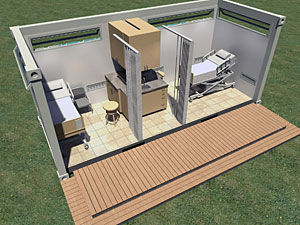As the efforts to rebuild Haiti after its devastating January 12 earthquake inch along, a medical clinic is headed to the island nation that can be set up quickly and opened straight away.



Pre-built inside a pair of 20-foot-long steel shipping containers that can be loaded onto boats, the clinic is set to arrive in Port-au-Prince around the beginning of June, according to Containers to Clinics, the Dover, Massachusetts-based nonprofit that developed it.
Co-designed by Anshen + Allen, an international healthcare-focused firm based in San Francisco, and Stack Design Build, of Pawtucket, Rhode Island, the clinic is made up of two containers laid out in an L-shape, six feet apart, and connected by a small platform, with interiors that resemble a typical doctor’s offices.
But each of the containers will have slightly different functions. One, which was donated by a New Jersey junkyard, will feature a pair of examination rooms, where pregnant women can get checkups and children can get vaccinations. The other, purchased at a discount from a Massachusetts storage company, will be divided into a lab and pharmacy; it will also have a check-in window for patients, who will wait on chairs outside.
Supplies, meanwhile, will come from AmeriCares, while doctors will be staffed by Management Sciences for Health, a Cambridge, Massachusetts-based not-for-profit. Staff will also be provided by Haiti’s Ministry of Health.
“This was a simple concept that even my seven-year-old could understand,” says Elizabeth Sheehan, the company’s founder and president, of her creation.
But, Sheehan adds, it took 25 tries to settle on a design, largely because of concerns about heat, which was addressed with a “special sauce” of reflective white paint, insulation, louvered windows, and solar-powered fans.
Plus, shade will be provided by a sailcloth canopy stretched over the containers and waiting area, giving the whole assemblage the look of a square if viewed from above.
“The containers won’t maintain 71 degrees. It’s going to be warm in there,” says Ryan Campbell of Anshen + Allen. “But the idea is to have it be ventilated even if the power dies.”
The clinic, which will be transported in two pieces, is set to leave Boston around May 15 in a truck, which will haul it to Brooklyn, New York, where it will be loaded on a freight ship. By June, it’s to be set up on the grounds of Graces Children’s Hospital in Port-au-Prince.
Though the clinic is the first from the nearly two-year-old Containers to Clinics, the organization plans to roll out 50 clinics in the next 10 years to rural areas in India, Central America, and Southeast Asia underserved by medical facilities. Future containers will likely be donated by Maersk Line, the global shipping company, Sheehan predicts.
With bulk orders, the cost to manufacture the clinics, which was $80,000 for the Haiti version, is expected to drop “by orders of magnitude,” says Andy Keating, a principal of Stack Design Build. His firm, which specializes in projects that use recycled materials, recently created a three-story office out of similar containers.
Savings could also be realized, Keating says, if future clinics are built overseas, in ports where unused containers often pile up. “Containers are very, very durable,” Keating says, “and an available resource around the globe.”
Read related news in our special section, Rebuilding Haiti.
Editor’s Note: The original story did not credit Stack Design Build as a designer of the project. Also, Containers to Clinics has modified the number of units it plans to produce; it hopes to roll out 50 in the next 10 years, not 50,000 in the next 15 years as initially stated.



Post a comment to this article
Report Abusive Comment